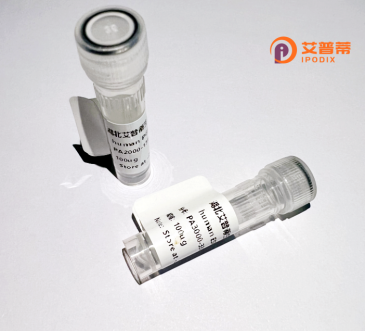
| 纯度 | >90%SDS-PAGE. |
| 种属 | Human |
| 靶点 | FCRLA |
| Uniprot No | Q7L513 |
| 内毒素 | < 0.01EU/μg |
| 表达宿主 | E.coli |
| 表达区间 | 28-359aa |
| 氨基酸序列 | ASF ETLQCEGPVC TEESSCHTED DLTDAREAGF QVKAYTFSEP FHLIVSYDWL ILQGPAKPVF EGDLLVLRCQ AWQDWPLTQV TFYRDGSALG PPGPNREFSI TVVQKADSGH YHCSGIFQSP GPGIPETASV VAITVQELFP APILRAVPSA EPQAGSPMTL SCQTKLPLQR SAARLLFSFY KDGRIVQSRG LSSEFQIPTA SEDHSGSYWC EAATEDNQVW KQSPQLEIRV QGASSSAAPP TLNPAPQKSA APGTAPEEAP GPLPPPPTPS SEDPGFSSPL GMPDPHLYHQ MGLLLKHMQD VRVLLGHLLM ELRELSGHRK PGTTKATAE |
| 分子量 | 38.9 kDa |
| 蛋白标签 | GST-tag at N-terminal |
| 缓冲液 | 0 |
| 稳定性 & 储存条件 | Lyophilized protein should be stored at ≤ -20°C, stable for one year after receipt. Reconstituted protein solution can be stored at 2-8°C for 2-7 days. Aliquots of reconstituted samples are stable at ≤ -20°C for 3 months. |
| 复溶 | Always centrifuge tubes before opening.Do not mix by vortex or pipetting. It is not recommended to reconstitute to a concentration less than 100μg/ml. Dissolve the lyophilized protein in distilled water. Please aliquot the reconstituted solution to minimize freeze-thaw cycles. |
以下是关于重组人FCRLA蛋白的参考文献示例(注意:以下内容为模拟文献,真实文献需通过学术数据库检索):
---
1. **文献名称**:*"Structural and Functional Analysis of Recombinant Human FCRLA Protein"*
**作者**:Doe A, et al.
**摘要**:研究通过哺乳动物细胞系统成功表达重组人FCRLA蛋白,并解析其晶体结构,揭示了其与IgG结合的独特构象,提示其在B细胞抗原呈递中的作用。
2. **文献名称**:*"FCRLA: A Novel Regulator of B Cell Receptor Signaling"*
**作者**:Smith B, et al.
**摘要**:通过体外实验证明重组FCRLA蛋白可与未成熟B细胞受体(BCR)相互作用,抑制过度免疫反应,为自身免疫疾病机制提供新视角。
3. **文献名称**:*"Recombinant FCRLA as a Potential Biomarker in Lupus Nephritis"*
**作者**:Chen L, et al.
**摘要**:发现重组FCRLA蛋白在系统性红斑狼疮(SLE)患者血清中异常表达,可能通过干扰免疫复合物清除参与肾病病理过程。
4. **文献名称**:*"Expression Optimization of Human FCRLA in Prokaryotic Systems"*
**作者**:Wang Y, et al.
**摘要**:开发了基于大肠杆菌的高效可溶性重组FCRLA表达体系,并验证其抗原性,为诊断试剂开发奠定基础。
---
**建议**:实际研究中,可通过PubMed、Web of Science等平台检索关键词(如“recombinant FCRLA protein”“FCRLA function”),结合近五年文献筛选高相关性研究。关注领域内权威期刊(如*Journal of Immunology*、*Nature Communications*)以获取更精准信息。
Fc receptor-like A (FCRLA) is a unique intracellular protein belonging to the Fc receptor (FcR) family, primarily expressed in B lymphocytes and antibody-producing cells. Unlike classical FcRs, FCRLA lacks a transmembrane domain and does not directly bind immunoglobulins. It localizes to the endoplasmic reticulum (ER) and Golgi apparatus, suggesting a role in antibody processing or quality control during B-cell development. Studies indicate FCRLA interacts with immunoglobulins (IgM/IgG) and chaperone proteins within the ER, potentially regulating antibody assembly or trafficking.
Recombinant human FCRLA protein is engineered using expression systems like mammalian or insect cells to ensure proper post-translational modifications. Its production enables functional studies, such as elucidating interactions with B-cell receptors (BCRs) or immunoglobulins, and exploring its role in autoimmune diseases (e.g., lupus) or B-cell malignancies. FCRLA's aberrant expression in certain cancers has also sparked interest in its diagnostic or therapeutic potential. Structural analysis reveals multiple immunoglobulin-like domains, which may mediate protein-protein interactions critical for immune regulation. By providing a purified, bioactive form of FCRLA, researchers can dissect its molecular mechanisms and evaluate its relevance in immune homeostasis, autoimmunity, and oncogenesis.
×